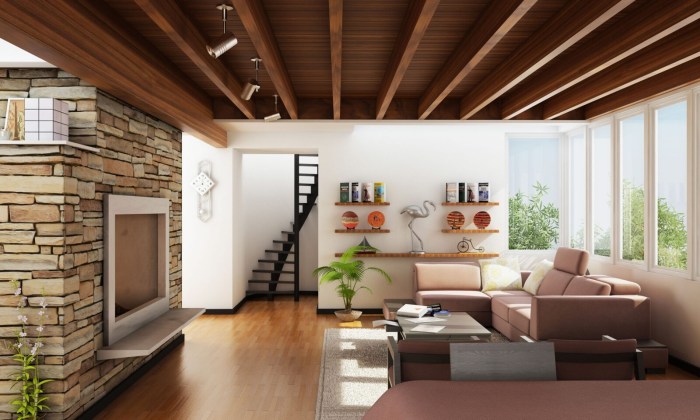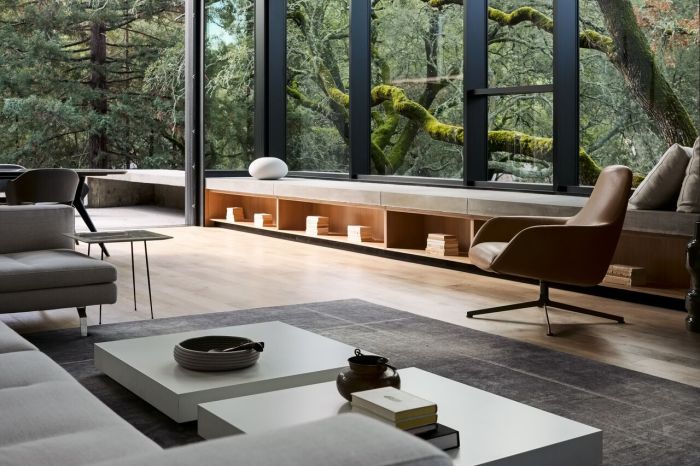Embark on a journey through the intricate world of interior architecture, where design meets functionality in captivating ways. This introduction sets the stage for a deep dive into the key aspects of this dynamic field, offering insights that will inspire and inform readers.
As we delve further, we will uncover the core principles, spatial design concepts, material selections, technology integrations, and cultural influences that shape the realm of interior architecture.
Understanding Interior Architecture
Interior architecture refers to the design and planning of interior spaces in a way that combines functionality, aesthetics, and technical aspects. It involves creating spaces that are not only visually appealing but also serve a specific purpose or function. Interior architecture plays a crucial role in shaping the experience of individuals within a built environment.The relationship between interior architecture and interior design is closely intertwined.
While interior design focuses on the aesthetics, decor, and furnishing of a space, interior architecture deals with the spatial layout, structural elements, and overall design of the interior environment. Interior architecture sets the foundation for interior design, providing the structural framework on which the decorative elements are built upon.Key elements that differentiate interior architecture from interior design include the consideration of structural integrity, building codes and regulations, spatial planning, circulation flow, and the integration of technology within the space.
Interior architects often work closely with architects, engineers, and other professionals to ensure that the interior spaces are not only visually appealing but also safe, functional, and sustainable.
Principles of Interior Architecture
Interior architecture is guided by several fundamental principles that help designers create functional, aesthetically pleasing spaces. These principles include aspects such as balance, harmony, scale, proportion, and rhythm. By understanding these principles, designers can effectively plan and design interior spaces to meet the needs of their clients while creating visually appealing environments.
Comparison with Other Design Disciplines
Interior architecture shares some principles with other design disciplines like graphic design and industrial design. For example, the concept of balance is crucial in all design disciplines to create a sense of visual equilibrium. However, interior architecture focuses more on the spatial arrangement of elements within a physical space, while graphic design deals with visual communication and industrial design focuses on product functionality.
Application in Real-world Projects
In real-world projects, the principles of interior architecture are applied in various ways. For instance, designers use scale and proportion to ensure that furniture and decor items fit harmoniously within a space. Rhythm is created through the repetition of design elements like patterns or colors throughout a room.
Balance is achieved by distributing visual weight evenly in a space, while harmony ensures that all elements work together cohesively. By applying these principles, interior architects can transform ordinary spaces into functional and visually appealing environments.
Spatial Design in Interior Architecture

Spatial design plays a crucial role in creating functional and aesthetically pleasing interiors. It involves the arrangement of elements within a space to optimize usability, flow, and visual appeal. Let's delve deeper into the significance of spatial design in interior architecture.
Role of Spatial Design
Spatial design is essential in interior architecture projects as it determines how people interact with and navigate through a space. By carefully planning the layout, circulation paths, and zoning of different areas, designers can ensure that the space is not only visually appealing but also practical and efficient.
This attention to spatial planning directly impacts the overall user experience within the interior.
Importance of Spatial Planning
Spatial planning is a fundamental aspect of interior architecture projects as it helps in organizing the space effectively to meet the functional requirements of the users. Through thoughtful consideration of proportions, scale, and relationships between various elements, designers can create harmonious interiors that cater to the needs and preferences of the occupants.
Proper spatial planning also contributes to the safety, comfort, and overall well-being of the users.
Enhancing User Experience through Spatial Design
Spatial design enhances user experience in different interior spaces by creating environments that are not only visually appealing but also conducive to specific activities or functions. For instance, in a residential setting, well-designed spatial layouts can promote relaxation, social interaction, and privacy.
In a commercial space, spatial design can influence customer behavior, brand perception, and overall satisfaction. By focusing on user needs and preferences, designers can craft interiors that are both functional and emotionally engaging.
Materials and Finishes in Interior Architecture
When it comes to interior architecture projects, the selection of materials and finishes plays a crucial role in shaping the overall design concept. The materials used not only determine the aesthetic appeal of a space but also impact its functionality and sustainability.
In this discussion, we will delve into the importance of materials and finishes in interior architecture, focusing on their selection, impact on design, and sustainable practices.
Selection of Materials in Interior Architecture
The selection of materials in interior architecture involves considering factors such as durability, maintenance, cost, and aesthetics. Different materials, such as wood, metal, glass, and stone, offer unique characteristics that can enhance the design of a space
It is essential for interior architects to carefully choose materials that not only align with the design concept but also meet the functional requirements of the space.
Impact of Materials and Finishes on Design Concept
Materials and finishes have a significant impact on the overall design concept of an interior space. The choice of materials can define the style of a space, whether it's modern, traditional, minimalist, or eclectic. For instance, the use of marble flooring and brass accents can evoke a sense of luxury and sophistication, while exposed brick walls and concrete finishes can create an industrial and raw aesthetic.
The combination of different materials and finishes allows interior architects to create a cohesive design that reflects the client's vision and the intended use of the space.
Sustainable Practices and Trends in Material Selection
In recent years, there has been a growing emphasis on sustainable practices in interior architecture, including the selection of eco-friendly materials and finishes. Interior architects are increasingly opting for sustainable materials like reclaimed wood, bamboo, recycled glass, and low VOC paints to reduce environmental impact and promote healthier indoor environments.
Additionally, trends in material selection for interior architecture are shifting towards natural and biophilic design elements that connect occupants with nature, such as living plant walls, natural light, and organic textures. By incorporating sustainable practices and trends in material selection, interior architects can create spaces that are not only visually appealing but also environmentally conscious.
Technology Integration in Interior Architecture
Technology plays a crucial role in shaping the modern interior architecture landscape, revolutionizing the way we design and interact with interior spaces. Smart technologies have significantly influenced the design and functionality of interior spaces, offering innovative solutions for enhancing user experience and convenience.
Integration of Smart Technologies
The integration of smart technologies such as Internet of Things (IoT), artificial intelligence, and automation systems has transformed interior architecture by providing seamless connectivity and control of various elements within a space. For example, smart lighting systems can adjust brightness and color temperature based on natural light levels and user preferences, creating dynamic and energy-efficient environments.
Interactive Surfaces and Augmented Reality
- Interactive surfaces embedded with touch sensors or projection technology allow users to interact with digital content and customize their environment effortlessly.
- Augmented Reality (AR) applications enable designers and clients to visualize and experience proposed designs in real-time, facilitating better decision-making and design revisions.
Sustainable Technologies
- Integration of sustainable technologies such as solar panels, rainwater harvesting systems, and energy-efficient HVAC systems contribute to creating environmentally friendly and resource-efficient interior spaces.
- Smart thermostats and sensors help optimize energy usage and maintain comfortable indoor environments, promoting sustainability and cost savings.
Cultural Influences on Interior Architecture

Cultural influences play a significant role in shaping interior architecture around the world. Designers draw inspiration from various cultural traditions, beliefs, and practices to create spaces that resonate with people on a deeper level. Understanding and respecting these cultural factors is essential in designing interior spaces that are not only aesthetically pleasing but also meaningful and functional.
Importance of Cultural Sensitivity
Cultural sensitivity is crucial in interior architecture as it ensures that designs are respectful and inclusive of diverse cultural backgrounds. By being aware of and sensitive to cultural nuances, designers can avoid unintentional cultural appropriation or insensitivity in their work.
This approach allows for the creation of spaces that are welcoming and comfortable for people from different cultural backgrounds.
Incorporating Cultural Elements
Incorporating cultural elements into interior architecture can lead to the development of unique and engaging designs. By integrating symbols, colors, patterns, and materials that are culturally significant, designers can create spaces that tell a story and evoke a sense of place.
Whether through traditional craftsmanship, architectural styles, or historical references, cultural elements add richness and depth to interior spaces, making them more compelling and memorable.
Outcome Summary
In conclusion, interior architecture is a harmonious blend of artistry and practicality, shaping spaces that not only look beautiful but also function seamlessly. This discussion has only scratched the surface of this fascinating field, leaving room for endless exploration and creativity.
FAQ Explained
What is the significance of interior architecture in design?
Interior architecture plays a crucial role in creating functional and aesthetically pleasing interior spaces by focusing on the structural elements and spatial configurations.
How does interior architecture differ from interior design?
Interior architecture primarily deals with the structural layout and design of interior spaces, while interior design focuses more on the decorative aspects and furnishing of those spaces.
What are the key elements that differentiate interior architecture from interior design?
The key elements include a focus on spatial design, material selection, structural integrity, and the integration of technology to enhance user experience.









